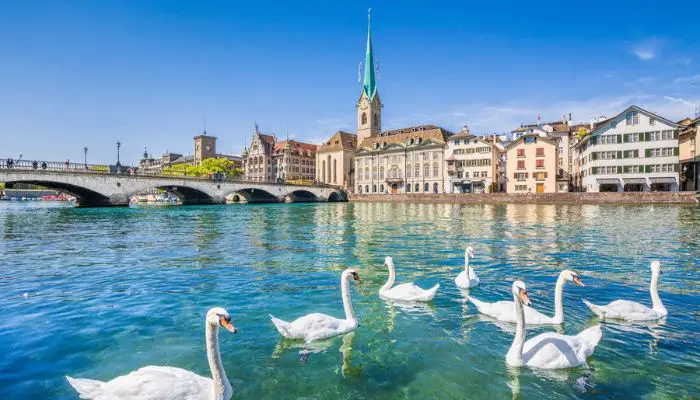Tourists will find Zürich, Switzerland’s largest city, to be a beautiful and fascinating location. Numerous museums, an old town full of well-preserved structures from the Renaissance and the Middle Ages, and enough artwork both inside and outside of museums to satisfy art aficionados for a week are just a few of the city’s many attractions and things to do.
Leading intellectuals including Georg Büchner, Vladimir Lenin, James Joyce, C. G. Jung, and Thomas Mann were drawn to Zurich because of its history of liberal thought and a vibrant intellectual scene. Zürich is one of the best cities in Switzerland to visit and is well-suited for sightseeing on foot, despite the fact that it is humming with commercial activity.
The 10 Best Attractions & Things to Do in Zurich
The city makes a wonderful starting point for exploring a variety of other fascinating locations in Switzerland and the neighbouring German Black Forest region. Many of these are actually worthwhile day trips from Zürich. Our list of the top things to do in Zürich will help you discover the greatest locations to visit.
1. Zurich Christmas Markets
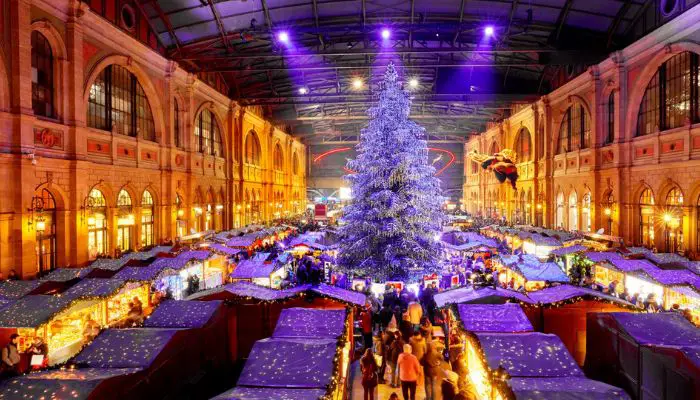
The month of December is a fun time to travel to Zurich because the city’s squares, streets, and train station are all lined with stalls selling holiday fare, presents, decorations, and handmade items. The Singing Christmas Tree, a pyramid-shaped platform made of evergreen boughs, is located among the market stalls on Werdmühleplatz.
Visitors can make their own Christmas candles at Bürkliplatz, and there are kid-friendly attractions like carousels scattered throughout the markets.
One of the biggest Christmas markets in Europe takes over the enormous Bahnhof, whose main hall is transformed into a brilliant world of lights, with a 50-foot Christmas tree that is totally decked out in Swarovski crystal ornaments as its focal point. More than 6,000 decorations from this year and previous years are displayed on the tree.
2. Confiserie Sprüngli: A Confectioner’s Café
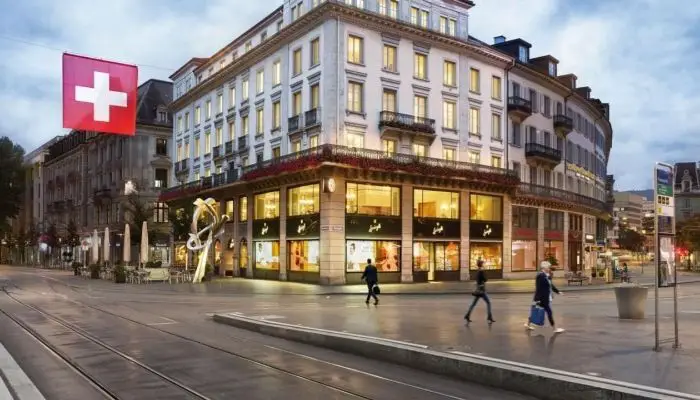
Sprüngli House, a confectioner’s café on Paradeplatz, was founded in 1856 and is now a popular destination for both locals and visitors. You’ll be attracted inside to at least feast your eyes on the exquisitely displayed truffles (made fresh each day), bonbons, cakes, and their distinctive macarons, known as Luxemburgerli, after just one glance at the towers of tempting goods in the window.
The retail store is located on the ground floor, while the upstairs café-salon offers upscale surroundings in which to have breakfast, lunch, and afternoon treats.
3. Bellerive Museum
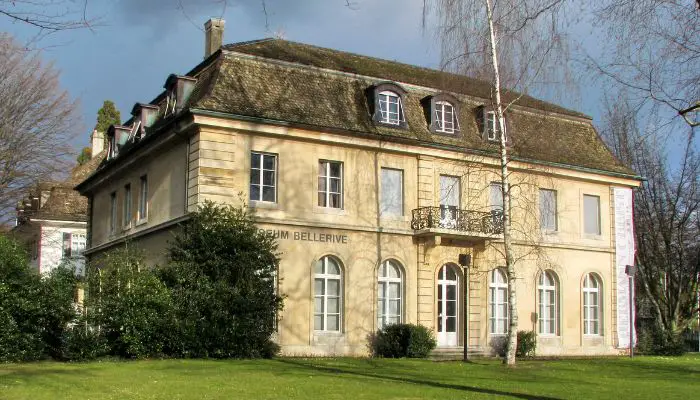
The Bellerive is the most significant museum of applied arts in Switzerland because to its astoundingly extensive holdings. These are displayed in a variety of shows that explore a range of subjects and ideas while fluidly transitioning between visual arts and design and different historical eras.
The Bellerive is notably strong in artwork from the Art Nouveau era in various mediums, with especially priceless ceramic pieces. Textiles, contemporary ceramics, and marionettes manufactured by 20th-century artists are some further specialties. The collections contain 200 old musical instruments.
4. St. Peter’s Church

St. Peter’s Church is located on a small hill in the area of the Old Town that is on the west bank of the Limmat, south of the Lindenhof. It is Zürich’s oldest parish church, with a Romanesque choir from the early 13th century under the tower and a Baroque nave with three aisles and galleries.
Under the chancel, the ancient foundation from the ninth century is visible. The church still owns the title for having the largest clock dials in Europe, which measure 8.7 metres in diameter, which it gained in 1538.
5. Rietberg Museum
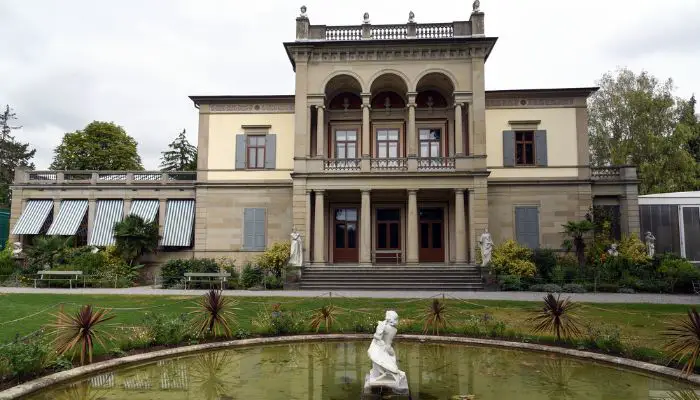
The excellent collection of Baron Eduard von der Heydt is kept in a Neoclassical villa that was constructed in the style of the Villa Albani in Rome and is claimed to be an identical replica. For a German businessman, the villa was constructed in 1857. Zürich intellectuals congregated there.
It houses collections of Indian sculpture, Tibetan images and bronzes from temples, Chinese grave decorations, Buddhist stele, and Asian ceramics and jade, making it the sole museum dedicated to non-European art in Switzerland. Along with a collection of African carvings, masks, and bronzes, there are also works of art from the Pacific, the Near East, and North America.
The villa is located in the lovely Rieter Park, a walking-path-equipped English landscape garden.
6. Niederdorf and the Old Town
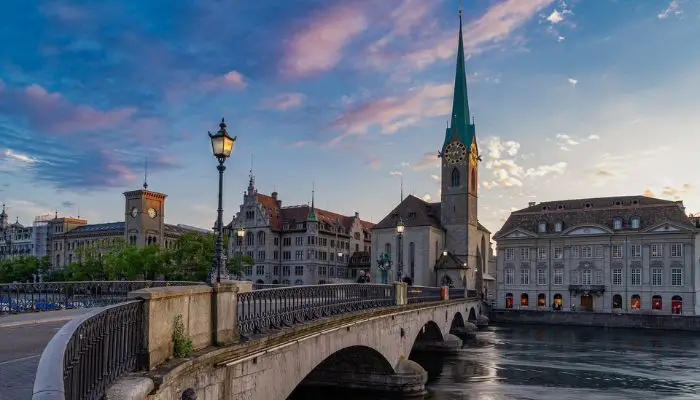
A neighbourhood with historic appeal is located in the middle of this contemporary financial hub of a city, with its winding streets rising steeply on the east side of the river. With shops, eateries, and cafés, the Niederdorf neighbourhood is one of the busy mediaeval streets and squares.
As you continue up Münstergasse, you’ll reach the Napfgasse and the Brunnenturm, which served as the Lombard moneychangers’ administrative centre in the 14th and 15th centuries. At number 6, Haus zum Napt features a lovely interior with rooms decorated in the Renaissance style.
Lenin resided in a home on Spiegelgasse at number 17 in 1917. The Dada art movement was established in 1916 on this street at Cabaret Voltaire by Hans Arp and Tristan Tzara. The Hans zum Rech, which dates from the Middle Ages and demonstrates how decorative styles developed throughout the years, and the Shoemakers’ Guild House, which is now a theatre, may be found along Spiegelgasse, which runs east into the Neumarkt.
At the very least, enter to view the courtyard and the replica of Zürich in 1800. The inside still has 17th-century painted walls and ceilings as well as exquisite ornate ironwork. At number 27, there is a building that was formerly a home built in the 13th century. Along with cafes and restaurants, these streets are home to boutiques and antique stores.
7. Ride the Train up the Uetliberg
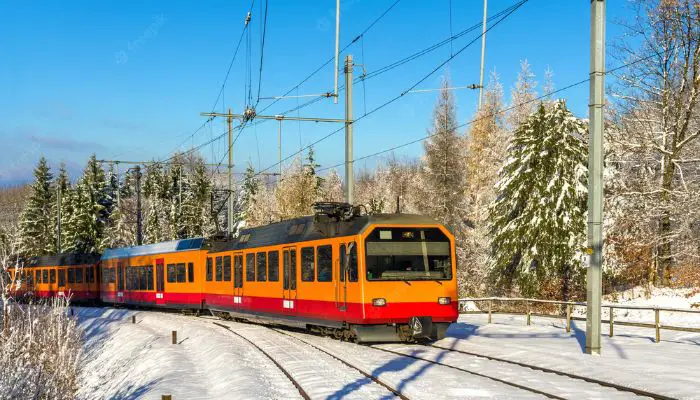
Follow locals to the 871-meter Uetliberg, their favourite weekend hangout, for the greatest views of the city and the lake. The Uetliberg, the most northerly summit on the Albis range, is located southwest of Zürich and is easily accessible through the Uetlibergbahn, a mountain railroad that runs throughout the year from Selnau station to the upper station. The summit is a 10-minute walk from here.
The summit restaurant is located at the end of a wide promenade that is well-lit at night. The restaurant is wrapped in glass and offers stunning views of the city lights below. The Black Forest to the north and the Säntis to the east are visible from the observation tower during the day as are the Valais, Bernese, and Glarus Alps. From here, it takes about an hour to travel down a flat ridge to the Felsenegg, where a cable car lowers to Adliswil.
You can take the Sihltalbahn back to Zurich. One of the locals’ favourite winter activities in Zürich is taking a ride to the Uetliberg for a fondue dinner and views of the city’s lights reflected in the snow.
8. Play on Lake Zürich
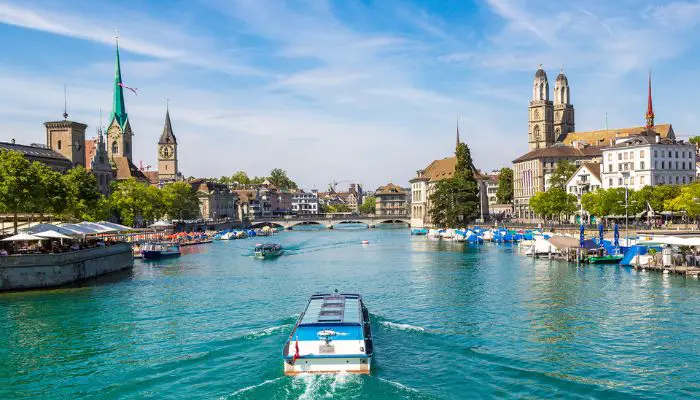
The long Lake Zürich is the centre of Zürich and a popular playground for visitors and locals. Promenades and parks along the entire shore, providing inhabitants with places to relax, exercise, picnic, and swim in the lake.
On one of the many cruises that offer breathtaking views of the Glarus Alps, vacationers’ preferred method of enjoying the lake is. Watch for the steamer to land at Bürkliplatz, where the Limmat empties into the lake. In order to connect Bellevueplatz with Bürkliplatz, the Quaibrücke spans the river.
The lovely Zürichhorn Park, created in 1939 for the National Exhibition, is located about 1.5 kilometres from Bellevueplatz. The Limmatschiff, a boat that travels from the National Museum along the river to the lake and ends at Zürihorn, has a boat dock here, as well as a restaurant, a Chinese Garden, and other amenities.
9. Bahnhofstrasse and the Bahnhof
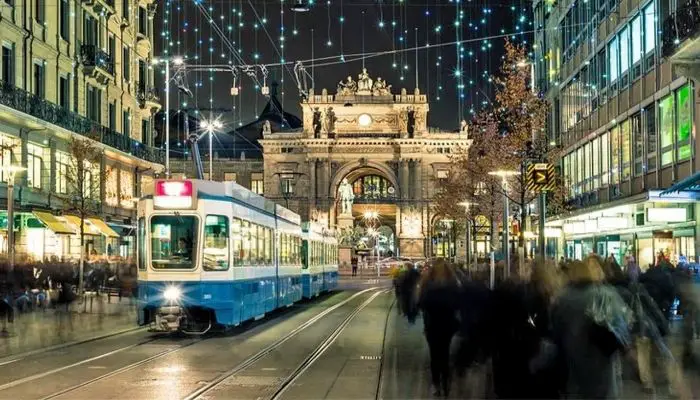
The popular Bahnhofstrasse, which runs from Zürich’s main train station (bahnhof) to the Bürkliplatz at the tip of the lake, is referred to as the city’s “Main Street.” The 1,200-meter street, which is enhanced by fountains, public art, trees, and notable buildings, is one of the most beautiful retail avenues in Europe.
Even though many of the stores lining it are stocked with furs, clothes, jewellery, and other expensive things, the buildings themselves and their tastefully decorated windows make it a popular spot for people to wander. After an old moat, the Fröschengraben, was filled in, the centre section of the street was constructed in 1867; the portions leading to the lake and the station were constructed a few years later.
The Paradeplatz was first utilised as a livestock market in the 18th century and afterwards as a parade area. With its lofty hall packed with stores and cafes and a massive mall below, the majestic Bahnhof is in and of itself a draw. The Bahnhof hosts Zurich’s largest Christmas market.
10. Fraumünster
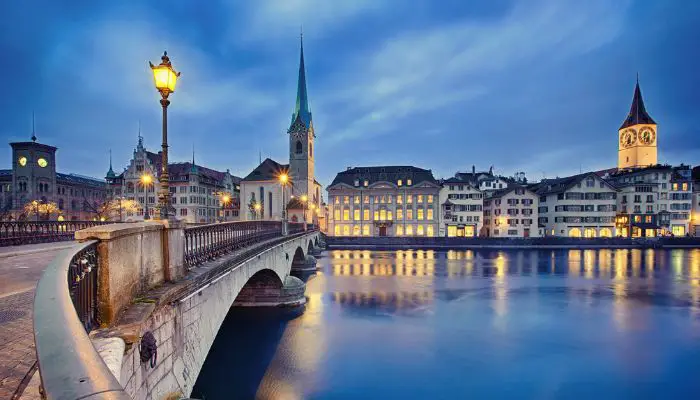
The name of the protestant Fraumünster, which is frequently mistranslated as “Church of Our Lady,” really refers to the convent that the Emperor Ludwig founded for his daughter Hildegard here in 853 for noble ladies of Europe. Up until the late Middle Ages, the convent’s superior served as the city’s administrator.
The church is a three-aisled, pillared basilica with an Early Gothic transept with high vaulting, a Romanesque chancel, and a Gothic nave constructed between the 13th and the 15th centuries. You can still see the crypt from the abbey church from the ninth century in the undercroft.
Marc Chagall also created the rosette in the southern transept. Another stunning stained glass window, The Heavenly Paradise, designed by Augusto Giacometti in the 1940s, may be found in the north transept. The abbey itself was destroyed in 1898 to make way for the Stadthaus, but the Romanesque and Gothic cloister still stands today. There, paintings by P. Bodmer from 1928 depict the founding tale of the monastery and the lives of Felix and Regula, the city’s patron saints.

